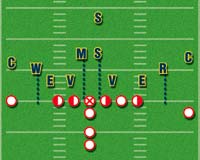AMERICAN FOOTBALL MONTHLY THE #1 RESOURCE FOR FOOTBALL COACHES
Article CategoriesAFM Magazine
|
Flexibility of a Split 4 Defense© More from this issueI am currently the defensive
coordinator at Boyd-Buchanan School. I have coached for eight years
and in seven of those eight we have been to the state playoffs.
In 2002, we finished state runner up and in 2003 we won the Class
A State Championship, 26-3. Our starting defensive unit only gave
up 14 touchdowns in 14 games, and here’s how we helped achieve
success: The split four is a simple gap control defense that has the ability to put eight
men in the box versus the run (Figure 1) and the flexibility to change to a 4-3
....The full article can only be seen by subscribers.
|
|
|||||||
| HOME |
MAGAZINE |
SUBSCRIBE | ONLINE COLUMNISTS | COACHING VIDEOS |
Copyright 2025, AmericanFootballMonthly.com
All Rights Reserved






